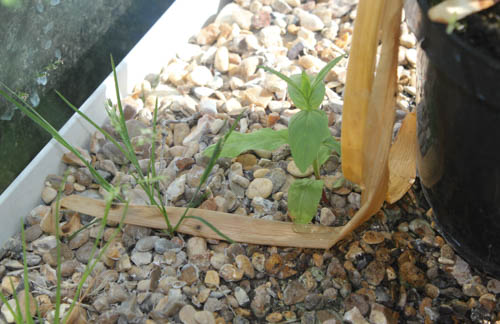
Sow sweet peas indoors from October to November. Soften the seed coat, by putting the seeds on a layer of kitchen towel on a dinner plate, put another layer on top. Dampen the towel, drain off excess water and sow as soon as they begin to swell or sprout, usually after about 48 hours. Those that don’t swell and germinate can be composted. Sow the living seeds individually into ‘Root Trainers’ or 9cm (3in) pots of seed compost or five to seven seeds to a 13cm (5in) pot, with the seeds spaced 2-3cm (¾-1¼in) apart, then cover the seeds with 1cm (½in) of compost. Water in gently, cover the pots with clear polythene then put them in a propagator or warm room at about 15°C (59°F). Remove the covering after they have germinated and overwinter the young plants in a cold frame or unheated greenhouse. If not sown individually, transplant single seedlings into 9cm (3in) pots once they have reached about 3.5 cm (1½in)
Weed greenhouse borders and pull out seedlings that have germinated in the gravel on the benches, particularly behind the back row of pots. Lift pots and remove and dispose of slugs that are hiding underneath and check over your plants regularly, removing yellowing or dead leaves and faded flowers before rots develop. Remove and compost any dead foliage affected by red spider mite or summer greenhouse pests.
Reduce watering of your pot plants, watering in the morning so they have dried out before temperatures drop at night and keep the glasshouse ventilated during sunny days, opening the louvre vents on the side of the greenhouse and those in the roof on the leeward side rather than opening the door, as sunny days are often accompanied by chilling winds.
Pot up chives, parsley and mint, and bring them into the greenhouse. Keep them slightly moist, the growth they put on over winter, which can be harvested for use in the kitchen.
Bring tender plants like fuschias, pelargoniums and marguerites into a cool, frost-free greenhouse. Keep them just moist over winter. After the first frosts, lift and store dahlias, in trays of used multipurpose compost in a frost-free greenhouse, having first cut off the stems to within two inches of the base and turning them upside down so water drains out of the stems
Hippeastrum bulbs are now for sale ready for flowering at Christmas or the New Year. Start them into growth by watering sparingly at first; just a trickle of tepid water around the bulb, increasing the amount as growth appears. Once they are actively growing, keep the compost moist but not waterlogged and take care not to get the growth tip wet. They like temperatures between around 20 C once they are growing well move them indoors; a warm sunny window is ideal keeping them at this temperature prolongs the flowering period. (This applies to ‘Indian Azalea’s’, ‘Poinsettia’ and ‘Christmas cactus’ too). Stake the flower stems carefully to prevent them from falling over and rotate the pot a quarter of a turn each day, to encourage balanced growth.
Happy gardening. Matt


